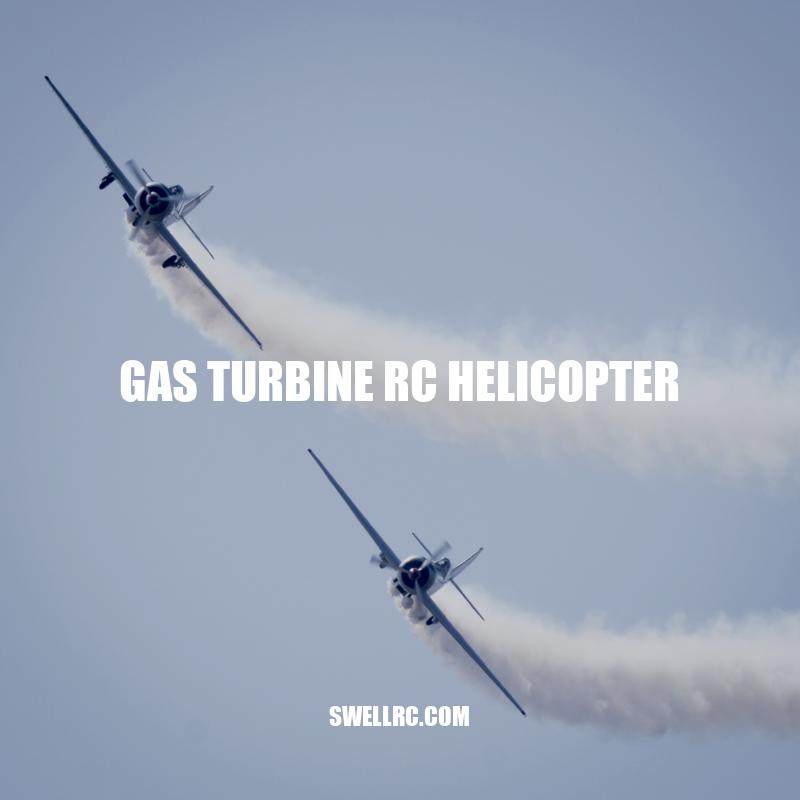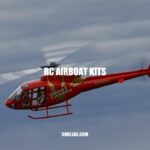Gas Turbine RC Helicopters: Power and Efficiency in Remote-Controlled Flight
Gas turbine RC helicopters have become an increasingly popular choice amongst hobbyists, thanks to their high power and efficiency. These helicopters are powered by small gas turbine engines that operate on the principles of gas combustion, which leads to the production of highly pressurized hot gasses that are directed towards turbine blades. The turbine blades drive the gearbox and rotor system to provide lift and propulsion to the helicopter. Gas turbine engines offer multiple advantages over their nitro or electric counterparts, including higher performance and output. They also require less fuel compared to traditional models and provide more extended flight times, making them the go-to option for individuals who are looking for long-duration hobby activities. Gas turbine-powered RC helicopters are available in different sizes and designs to suit a wide range of skills and preferences, and the parts and components are readily available from reputable vendors. Additionally, modern radio control technology offers modellers enhanced precision and control, unlike in the past, making gas turbine RC helicopters easier and safer to fly.
Advantages of Gas Turbine RC Helicopters
Gas turbine RC helicopters are highly sought-after by hobbyists because of their numerous benefits. Some of the advantages include:
- Higher power and performance: Gas turbine engines produce more power and can operate at higher RPMs than traditional nitro engines, allowing RC helicopters to achieve faster speeds and higher altitudes.
- Better efficiency: Gas turbine engines are highly efficient and have a low fuel consumption rate compared to nitro engines. This allows them to operate at a relatively low temperature and prevents overheating.
- Longer flight times: Gas turbines RC helicopter offers extended flight time compared to battery-powered electric or nitro models, making them ideal for longer-duration flying activities.
- Easy maintenance: Unlike nitro engines, which require regular use to prevent damage, gas turbines are designed for intermittent use, making them easier to maintain.
- Availability of parts and components: Gas turbine RC helicopter parts, and components are readily available from authorized dealers and hobby shops, making repairs and upgrades convenient.
If you’re interested in gas turbine RC helicopters, there are several websites and forums that you can visit to learn more about them. Websites like HobbyKing, MotionRC, and RC Universe offer diverse gas turbine RC helicopter options, from starter models to high-performance options, along with other accessories and parts. Some forums like RCGroups or HeliFreak offer a community of seasoned hobbyists who can offer expert help, advice, and guidance on everything related to gas turbine RC helicopters, from maintenance and upgrades to choosing the right models for your skill level.
Gas turbine RC helicopters are equipped with gas turbine engines that use a unique propulsion system to lift and propel the aircraft. The engine’s rotating components drive the helicopter’s rotor blades, providing lift, stability, and maneuverability. Here’s a breakdown of how a gas turbine engine works in an RC helicopter:
- The engine takes in air through an inlet, which is compressed by a turbine compressor stage.
- Fuel is injected into the combustion chamber, where it mixes with compressed air and ignited. The resulting hot gases rapidly expand, creating high-velocity exhaust gases.
- The exhaust gases exit the combustion chamber, passing through the turbine section, which houses a set of combustion and exhaust turbines that are connected by a shaft. The turbine section converts the energy of the exhaust gases into mechanical energy, which powers the helicopter blades.
- The remaining exhaust gases exit the exhaust nozzle and produce thrust.
There are several different types of gas turbine engines used in RC helicopters, including axial flow, radial flow, and centrifugal flow engines. Each type offers different benefits and drawbacks, and it’s essential to choose the right engine for your specific needs.
Here are some interesting facts about gas turbine engines used in RC helicopters:
| Fact | Explanation |
|---|---|
| Gas turbine engines can produce up to 4 times the power of nitro engines | This means gas turbine helicopters can achieve much higher speeds and altitudes than nitro helicopters. |
| Gas turbines are commonly used in commercial aircraft | Gas turbines are highly efficient and reliable, making them suitable for large-scale aircraft use. |
| Gas turbine engines require careful maintenance | While gas turbines are more convenient to maintain than nitro engines, they still require precise maintenance and care to keep them running optimally. |
If you want to learn more about how gas turbine engines work in RC helicopters and which type is right for you, there are several online resources available. Websites like HeliFreak and RCGroups have active user communities that can offer advice and tips. Additionally, online retailers like Horizon Hobby and Scalpel Heli offer a range of gas turbine helicopters and parts.
How do RC turbine engines work?
RC turbine engines work by utilizing the combustion process to produce thrust. Here are the steps:
1. Fuel is introduced to a combustion chamber.
2. A spark ignites the fuel, creating a flame.
3. The expanding gases from the combustion push against a turbine wheel, causing it to spin.
4. The spinning turbine is connected to a shaft that powers a compressor.
5. The compressor compresses intake air and pushes it into the combustion chamber.
6. The repeated sequence creates a continuous flow of thrust.
RC turbine engines are typically used in high-performance remote-control aircraft and helicopters. Resources like Modelflight and RC Planet offer an extensive range of RC turbine engines and parts for those interested in exploring their capabilities.
Tips for Operating a Gas Turbine RC Helicopter
Flying a gas turbine RC helicopter requires skill, experience, and attention to safety guidelines. Here are some tips to help you operate a gas turbine helicopter safely and effectively:
- Wear protective gear: Always wear eye, ear, and head protection when operating a gas turbine RC helicopter.
- Fly in safe areas: Fly your helicopter in open and safe areas, away from people, buildings, and other hazards.
- Maintain your helicopter: Regularly inspect your helicopter for wear and tear, loose components, and other issues that could compromise safety or performance.
- Use quality fuel: Use high-quality fuel that is recommended for your specific engine and helicopter model.
- Take lessons: Consider taking lessons or joining a hobby group to learn from other experienced pilots and improve your skills.
Additionally, there are several products and tools that can help you operate a gas turbine RC helicopter more safely and efficiently. Here are some examples:
| Product | Explanation |
|---|---|
| Radio transmitters | High-quality radio transmitters can improve communication and control between you and your helicopter, allowing for smoother flight and easier operation. |
| Fuel pumps | Fuel pumps make it easier to fill up your helicopter’s tank and ensure that it is filled to the proper level. |
| Safety switches | Installing a safety switch can prevent your helicopter from accidentally starting or running, reducing the risk of injury or damage. |
| Flight simulators | Using a flight simulator can help you practice flying and improve your skills without risking damage to your helicopter. |
To find these products and more, check out online retailers like HobbyKing and AMain Hobbies, which offer a wide variety of RC helicopter parts and accessories. Additionally, many hobby groups and forums have sections devoted to buying and selling used RC helicopter equipment.
How hard is it to learn to fly a RC helicopter?
Learning to fly a RC helicopter can be challenging but it is not impossible. The difficulty level depends on the type of helicopter you have and your experience level.
Here are some factors that can affect the learning process:
| Factor | Impact on learning |
|---|---|
| Type of helicopter | Complex models require more skill and experience to fly. Beginners should start with simpler models. |
| Experience level | Someone who has experience with RC airplanes or drones may find it easier to learn to fly a RC helicopter. |
To make the learning process easier, it is recommended to:
- Start with a beginner-friendly model.
- Practice basic maneuvers in a large, open space with no obstacles.
- Seek advice from experienced pilots or join a local RC club for guidance.
Online tutorials and instructional videos can also be helpful resources. Websites like Horizon Hobby offer RC helicopter models for beginners and advanced pilots, as well as tutorials and support for their products.
Conclusion
In conclusion, flying a gas turbine RC helicopter can be a thrilling and rewarding experience for hobbyists who are passionate about remote-controlled aircraft. By following safety guidelines and using the right equipment and tools, you can operate your helicopter with confidence and enjoy the freedom and excitement of flying.
It’s important to remember, however, that operating a gas turbine RC helicopter requires skill, experience, and a commitment to safety. Always take the time to learn and practice before attempting difficult maneuvers or flying in challenging conditions.
If you’re interested in learning more about gas turbine RC helicopters, there are many online resources, hobby groups, and forums available to connect with other enthusiasts and get advice and guidance. Whether you’re a seasoned veteran or just starting out, the world of gas turbine RC helicopters offers endless opportunities for fun and discovery. So why not take the leap and start exploring this exciting world today?



